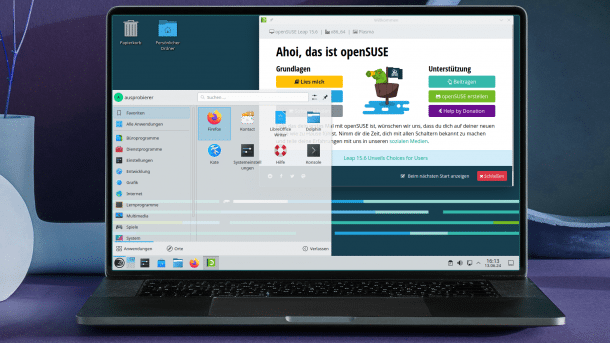openSUSE Leap 15.6 released: Last version before paradigm shift
Before the transition to an "immutable" Linux distribution in which containers play the main role, openSUSE Leap 15.6 delivers welcome updates.

Still no leap in the version series: The refreshed openSUSE Leap 15.6 is based on the long-established RPM base one year after the previous version. Core components such as the kernel, the Gnome desktop environment and the Pipewire sound server have made major version jumps, but the fundamental conversion to an "immutable" system with containers is still at least a year away.
openSUSE Leap 15.6 shares the package base with SUSE Linux Enterprise 15 Service Pack 6, the enterprise version with professional support, which is currently still available as a release candidate. The straightforward migration path from Leap to SUSE Linux Enterprise was the original reason for establishing binary compatibility with openSUSE Leap 15.3 and remains in place.
The software from the Enterprise repository is now well established, so that openSUSE Leap supplements packages that are particularly important for desktop use with selected newer versions from the "Factory" repository.
Impressions of openSUSE Leap 15.6 (4 Bilder)

Mehrere Desktops zur Auswahl
Dusty KDE Plasma Desktop
Users will be pleased with the relatively fresh kernel, which jumps from 5.14.21 to version 6.4. Also included are bug fixes for newer kernel versions as backports. The graphics library Mesa provides better support for AMD graphics chips in the current version 23.3.4 from the beginning of the year. The developers followed Fedora's example and compiled the hardware acceleration for the h264, h265 and VC1 codecs out of the hardware acceleration API (VA-API).
On the desktop, Gnome 45 is a newer, albeit not the latest Gnome environment. KDE Plasma, on the other hand, remains at the latest version 5.27.11 with long-term support. This is the first time that KDE Plasma has been relegated to a minor role in this distribution. KDE Plasma 6 is only planned for the successor. If you don't want to wait that long and always want the latest packages, you should take a look at openSUSE Tumbleweed, the rolling release version of openSUSE.
The installation media also offer the Xfce desktop, which is included in version 4.18, as a lean alternative. For manual installation, the repositories offer the desktops Cinnamon 6.0, Budgie 1.8, Lxqt 1.4 and Mate 1.2.6. Also on board are LibreOffice 24.2, Firefox ESR 115 and Thunderbird 115.
Cockpit web interface for administration
The release notes highlight Podman 4.8 as the container runtime. There is also Distrobox 1.7, which runs narrow Linux systems in containers via the terminal and integrates the network connection and home directory. For virtualization with KVM, there is libvirt 10.0 together with the brand new virt-Manager 4.1 as a graphical interface.
To manage the system as well as virtual machines and containers via a web interface, openSUSE 15.6 has adopted the Cockpit developed by Red Hat as a new addition. It is available for installation in the standard package sources and offers an additional administration interface via the web browser, also for remote access. As a graphical tool, Cocpit complements the in-house configuration file system YaST, which has become the trademark of Suse Linux and its successors and continues to retain control over basic configuration files and network settings. The BTRFS snapshots are also mapped via the YaST menus.
Last release of the version series 15
According to the developers' plans, openSUSE 15.6 will mark the end of this version series, which began in 2018 and has always enabled uncomplicated updates to the newer editions. With openSUSE 16, the distribution will be based on the Adaptable Linux Platform (ALP), an "immutable" core system. Users then upgrade server and user programs via app containers such as Flatpaks or in Podman containers, for example using Distrobox.
In an announcement about ALP, the developers assure that an immutable system will initially only be one of the installation options. There is also no particular hurry: If ALP is not in a stable state by the end of support for openSUSE Leap 15.6 at the end of 2025, a version 15.7 will be released as an unscheduled release. The packages will then come from SUSE Linux Enterprise 15 Service Pack 7.
Install or try out openSUSE Leap 15.6
Installation media for openSUSE Leap 15.6 are available in the download area of the openSUSE website. Either in the form of a bootable medium in DVD size (4.3 GByte) or as a minimal installer that obtains packages from the online repositories. Installable live images with KDE Plasma 5.27.11 and Gnome 45 are also available, albeit somewhat hidden.
(ds)